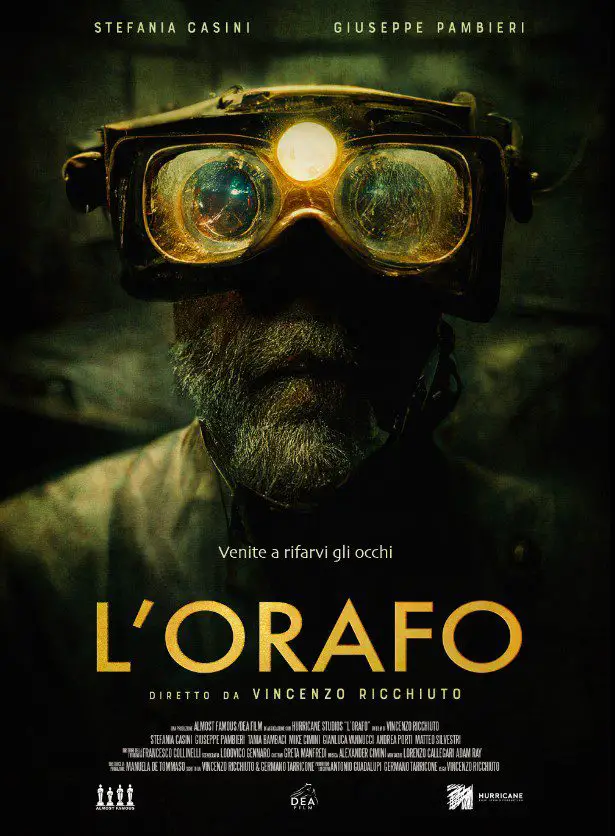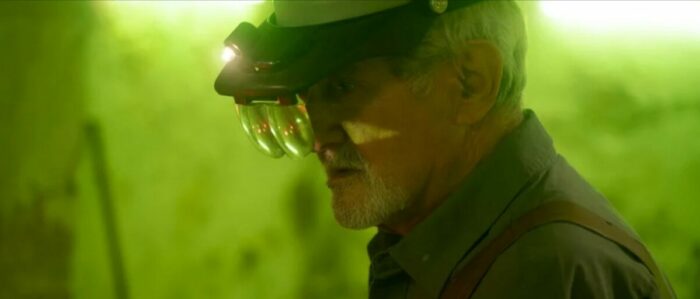In Vincenzo Ricchiuto’s The Goldsmith (L’orafo), a close-knit group of robbers have discovered the perfect score: a country farmhouse in the middle of nowhere. Though it looks indiscernible from any other home in the middle of nowhere, and the elderly couple living inside doesn’t look like anything notable, Stefano (Mike Cimini), Arianna (Tania Bambaci), and Roberto (Gianluca Vannucci) have set their sights on this location. After Roberto receives word that a Goldsmith lives and works out of the home, he alerts his gang, who’ve been causing all manner of mayhem since they were children, of the potential for obtaining some serious loot.
Once inside the home, nothing seems to go right. When the plan to slip in and out of the house goes awry, the burglars resort to hostage-taking and violently collect the information from their victims. Seemingly having the upper hand at first, the robbers tie up Antonio (Giuseppe Pambieri), The Goldsmith, and his wife Giovanna (Stefania Casini) and begin their raid on a secret room. When the door to the room closes, sealing them inside like a reverse Panic Room, it becomes frighteningly clear this mousetrap was designed for them as their hostages begin to leverage their visitors’ compromising position by pitting them against one another by revealing the secrets each is keeping from the others.

It’s not as though we haven’t seen this setup before. Films like Don’t Breathe, The People Under the Stairs, and Livid use this exact same plot of an easy-peasy home invasion for unsuspecting thieves only to have them discover a house of horror on the other side of a seemingly innocent front door. However, the difference between a film like The Goldsmith and any of the aforementioned titles is subtext. In Don’t Breathe and The People Under the Stairs, especially, the normalcy of a suburban setting is satirized. In contrast, The Goldsmith is a bit more rural and, surprisingly, one note. While it isn’t without its moments, the film relies on a delicate surface-layer story transpiring with a straightforward plotline and minimal subtext.
The film’s script, written by Ricchiuto and Germano Tarricone, is filled with amusing details that fit in an area of beguiling bemusement. It recalls similar head-scratching moments in Argento films, for example, needing a monster in Dracula 3D and using a human-sized praying mantis to satisfy the occasion. The Goldsmith imagines its situations and motivations with blunt candor, offering shallow backstory deviations for the characters to want to turn on each other, like the drug-addicted Roberto in the group may have performed fellatio on another man could be enough of a reason for his friends from childhood to want to dissociate.
So, given the fact that the characters are never fully defined outside of the situation we find them in, this example could make for an intriguing subplot from bigotry to acceptance in a friendship if the film ever decided to do more than out a subjectively out a queer character and end the conversation. But, despite the lengthy stares that go on too long between Stefano, Arianna, and Roberto that recall the awkward silences of Meet Joe Black (though never rise to that level), there’s very little character building between the three to allow you to care about them, making for little tension when the infighting progresses.

That about sums up the second act of The Goldsmith as well. We have our burglars on one side of the door and the elderly homeowners on the other, amounting to a Panic Room scenario without the tension. While this is the best opportunity for the audience to learn more about the film’s POV characters, the enigmatic Goldsmith and his wife become the most relatable. As the film progresses, you’re more likely to side with the violence The Goldsmith and his wife endeavor toward our less likable POV characters. And, speaking of endings, throwaway lines in the middle of The Goldsmith detail what to expect in that area, though the audience may not suspect where the film ends up exactly.
Morality and karma are the big themes that The Goldsmith serves up, as lies between friends dissolve their years-long bonds and articulate the fragility of secrets. I will admit that the movie is compelling, but it isn’t exactly original. The movie’s script almost feels templated from any number of home invasion thrillers, compounded with that gangster/hoodlum angle that accounts for a few extra scenes of brutality in the name of how viciously cold these characters can be.
The final act is delightfully off the rails in a mad scientist of the Hammer Horror era sort of way, it isn’t very subtle or surprising given the breadcrumbs that bring us there, but I have to praise how enjoyably berserk and tremendously fun the last bit of The Goldsmith is. It isn’t anything exceptionally new for horror fans. Still, something about the overly green lighting and the dingy space makes the film feel sinister, and there’s plenty of enjoyment in that. The Grimmfest synopsis of the film highlights how director Vincenzo Ricchiuto studied with Abel Ferrara, and the film’s finale highlights this extensively in the color palette and roller coaster music flourishes. It also offers a new sadistic family in the tradition of the Fireflies or The Sawyers that act as a moralistic folk fable to aid in the vague warning of films that explicitly tell us not to go in the house.
The Goldsmith (L’orafo) had its International Premiere as a part of Grimmfest on October 8. The film continues to tour the festival circuit.



